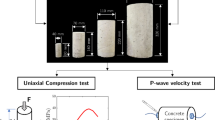Abstract
The interrelationship of the standard deviation, the coefficient of variation, and the compressive strength of concrete was studied on 32 building sites and 14 ready-mix plants, with more than 30,000 observations analysed. While the standard deviation was found to be practically strength-independent when overall values were considered, the coefficient of variation showed such independence in its daily values. It was further concluded that formal compliance with a set of nominal requirements does not necessarily secure the expected strength variation, in which respect the actual level of supervision is the dominant factor. The average overal standard deviation was of the order of 60 kg. per sq. cm. and the daily coefficient of variation—of the order of 10%, irrespective of nominal conditions of concrete production.
Résumé
Les relations entre l'écart-type, l'écarttype relatif et la résistance à la compression du béton varient selon qu'on considère les valeurs globales ou journalières. Dans ce dernier cas l'écart-type relatif est pratiquement indépendant de la résistance moyenne et devrait être par conséquent utilisé dans des conditions où le contrôle de qualité repose sur la production journalière. Par contre, si l'on considère les valeurs globales, c'est l'écart-type qui est pratiquement indépendant de la résistance et qui devrait être utilisé lorsqu'on pratique le contrôle de qualité en conséquence.
Se conformer strictement à une série de prescriptions nominales n'est pas une condition suffisante pour obtenir le degré de contrôle voulu et une variation prédéterminée de la résistance du béton. On peut donc en conclure que cette variation dépend beaucoup plus du niveau réel de surveillance des opérations que de la méthode de production ellemême, de l'appareillage utilisé, etc. On a constaté que l'écart-type global moyen était de l'ordre de 60 kg/cm2 et que l'écart-type relatif journalier était de l'ordre de 10% quelles que fussent les conditions formelles de la production de béton.
Similar content being viewed by others
References
Walker, S.—Application of Theory of Probability to Design of Concrete for Strength Specifications, paper presented at 14th Annual Meeting of the National Ready-Mixed Concrete Association, New York, January 27, 1944, N.R.M.C.A. Publication No. 57, Washington, D.C., p. 7.
A.C.I. Committee 214.—Recommended Practice for Evaluation of Compression Test Results of Field Concrete (A.C.I. 214-65), in A.C.I. Book of Standards, Part 1, Detroit, 1967.
British Standard Code of Practice C.P. 114: 1957.—The Structural Use of Reinforced Concrete. British Standard Institution, London, 1957.
Mudrock L. J..—The Control of Concrete Quality. Proceedings of the Institution of Civil Engineers, Part I, Vol. 2, No. 4, July 1953, pp. 426–453.
Erntroy, H. C..—The Variation of Works Test Cubes. Research Report. No. 10, Cement and Concrete Association, London, November 1960, p. 28.
Rüsch, H..—Zur Statistischen Qualitätskontrolle des Betons. Materialprüfung, Vol. 6, No. 11, November 1964, pp. 387–394. (See also English translation-Building Research Station Library Communication No. 1456,Statistical Quality Control of Concrete, January 1969).
Teychenné, D. C..—The Variability of the Strength of Concrete and Its Treatment in Codes of Practice. Structural Engineer, Vol. 3, Januarty/February 1966, pp. 30–47.
Philleo, R. E.—Private communication, 1969.
Comité Européen du Béton.—Recommendations for International Code of Practice for Reinforced Concrete. American Concrete Institute and Cement and Concrete Association, London, 1964.
Amendment No. 1 to C.P. 114: 1957 (see ref. 3),The Structural Use of Reinforced Concrete. British Standard Institution, London, February 1965.
D.I.N. 1045.—Bestimmung des Deutschen Ausschusses für Stahlbeton; Teil A-Bestimmungen für Ausführung von Bauwerken aus Stahlbeton, Entwurf Marz 1969.
Neville, A. M..—The Relation Between Standard Deviation and Mean Strength of Concrete Test Cubes. Magazine of Concrete Research, Vol. 11, No. 32, July 1959, pp. 75–84.
Soroka, I..—An Application of Statistical Procedures to Quality Control of Concrete. R.I.L.E.M. Bulletin Materials and Structures, Vol. 1, No. 5, September/October 1968, pp. 437–441.
Israel Standard Specification IS, No. 26.—Preparation and Testing of Specimens of Fresh Concrete, Israel Standards Institution, Tel Aviv, December 1965.
Rights and permissions
About this article
Cite this article
Soroka, I. On compressive strength variation in concrete. Mat. Constr. 4, 155–161 (1971). https://doi.org/10.1007/BF02479129
Published:
Issue Date:
DOI: https://doi.org/10.1007/BF02479129




